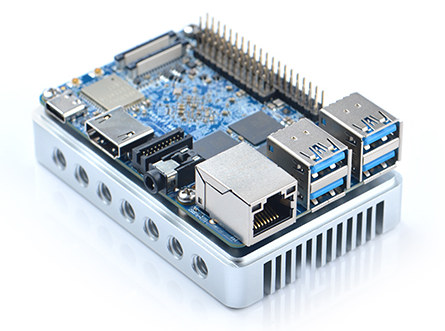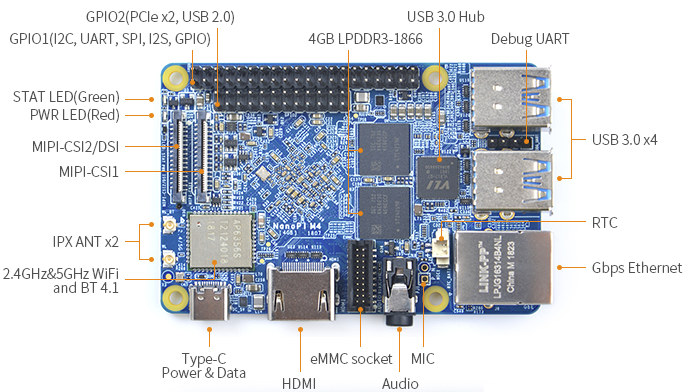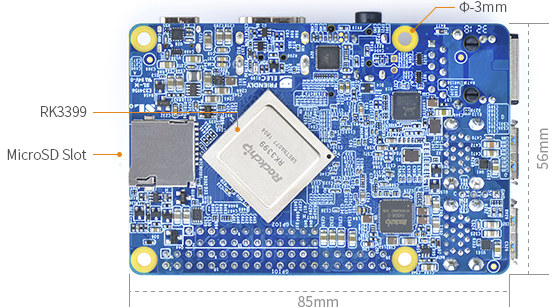As expected, FriendlyELEC has now launched NanoPi M4 board, a lower cost version of NanoPC-T4 Rockchip RK3399 SBC, and mostly following Raspberry Pi form factor.
How much you may ask? That would be $65 plus shipping for the 2GBRAM version, and $95 for the 4GB RAM version, which means it sells in the same ballpark as RockPro64 board.
NanoPi M4 board specifications:
- SoC – Rockchip RK3399 big.LITTLE hexa-core processor with 2x Arm Cortex-A72 @ up to 2.0GHz, 4x Cortex-A53 @ up to 1.5GHz, a Mali-T864 GPU with support OpenGL ES1.1/2.0/3.0/3.1, OpenVG1.1, OpenCL, DX11, and AFBC, and a VPU with 4K VP9 and 4K 10-bit H265/H264 6decoding
- System Memory – Dual-channel 4GB LPDDR3-1866, or dual-channel 2GB DDR3-1866
- Storage – eMMC module socket, micro SD card slot
- Video Output
- HDMI 2.0a up to 4K @ 60 Hz with HDCP 1.4/2.2 support
- 4-Lane MIPI-DSI connector
- Audio – 3.5mm headphone jack, HDMI digital audio output, microphone header
- Camera – one or two 4-lane MIPI-CSI connector (one multiplexed with MIPI-DSI), dual ISP up to 13MP
- Connectivity – Gigabit Ethernet, dual band 802.11 a/b/g/n/ac WiFi, Bluetooth 4.1 with 2x u.FL antenna connectors
- USB – 4x USB 3.0 ports, 1x USB 2.0 type-C port with OTG mode and power input
- Expansion
- 40-pin GPIO header with 3x 3V/1.8V I2C, up to 1x 3V UART, 1x 3V SPI, 1x SPDIF_TX, up to 8x 3V GPIOs, 1x 1.8V 8-channel I2S
- 24-pin extension port with 2x USB 2.0 interface, PCIe x2, 1x PWM
- Debugging – 4-pin UART header (3V 1.5Mbps)
- Misc – Power key, power LED, user LED, 2-pin header for RTC battery
- Power Supply – 5V/3A via USB-C port; RK808-D PMIC
- Dimensions – 85 mm x 56 mm (8-layer PCB)
- Temperature Range – 0 to 80
FriendlyELEC provides Android 7.1, Lubuntu Desktop, Ubuntu Desktop 18.04 64-bit, Lubuntu 16.04 32-bit, and Ubuntu Core 18.04 64-bit image for the board, as well as fairly good documentation – as usual – on the Wiki.
If you want to get an idea of the stability and performance of the Android 7.1 firmware reading NanoPC-T4 Android review would be a good indication, and as we’ve just seen in Firefly-RK3399 review, cooling is really important to get the most out of Rockchip RK3399 board.
 That’s why beside the board you should definitely add the $6.99 heatsink which cover the full area of the board (see above). Other accessories which you can tick during your order include a USB Type-C to USB-A male 2.0 cable (useful for firmware updates), an 8GB eMMC Module ($9.90) for better performance, a micro SD to eMMC adapter to flash firmware to the eMMC module, a 2.0MP USB camera module, a 13.2MP MIPI camera module ($25.00), a USB 1602 LCD Module, and/or for some hard-to- understand reasons, a mini USB WiFi dongle.
That’s why beside the board you should definitely add the $6.99 heatsink which cover the full area of the board (see above). Other accessories which you can tick during your order include a USB Type-C to USB-A male 2.0 cable (useful for firmware updates), an 8GB eMMC Module ($9.90) for better performance, a micro SD to eMMC adapter to flash firmware to the eMMC module, a 2.0MP USB camera module, a 13.2MP MIPI camera module ($25.00), a USB 1602 LCD Module, and/or for some hard-to- understand reasons, a mini USB WiFi dongle.

Jean-Luc started CNX Software in 2010 as a part-time endeavor, before quitting his job as a software engineering manager, and starting to write daily news, and reviews full time later in 2011.
Support CNX Software! Donate via cryptocurrencies, become a Patron on Patreon, or purchase goods on Amazon or Aliexpress







Typo: ‘NanoPC-T4 board specifications’ and additional info:
* all USB3 ports are behind an internal VL817 hub (which I consider one of the better USB3 hubs).
* board can also be powered through GPIO header (pins 2/4)
Curious whether we see some sort of ‘HATs’ making use of the 2 PCIe lanes on the 24-pin header and how powering situation will look like since it seems FriendlyELEC is not providing an own USB-C equipped PSU (and USB-C compliant PSUs might not provide 3A without additional negotiation).
Wow, FriendlyARM always done quite good! Hope to see better one 🙂
Where is the 2nd video output?:(
You can always use an external display via the MIPI DSI connector.
Finally! I tried to get one, but the site responded “no shipping options available”, I hope it’s only temporary, I would be sad not to be able to order cool stuff from there anymore! Maybe they didn’t register the weight yet or anything needed to compute the shipping cost…
Have the same issue…
I have not bought one but added one to shopping basket and estimated shipping. all seems fine?
I tried for UK by china post.
OK I found the problem, it’s the heatsink, it’s reported to weigh 300 kg, which is why there is no shipping option at this weight 🙂 I’ve reported it there, hoping it will get fixed soon.
No Shipping options are available for Russia still. ?
For me it was fixed this morning (for France). You should try again as I don’t expect the weight to vary by country, and if it still does not work you should contact them (the sales mail address is on their site). They normally respond quite quickly.
yep. I’ve got the same problem. I hope it will be on aliexpress.
Same problem here .. maybe I should not buy and stick to RockPro64 I already have. Friendlyarm is messed up.
They aren’t messed up. It’s day one to buy the board and some database entry is wrong (see Willy Tarreau’s post above).
Yes a VERY heavy board .. 300.20 Kg … 🙂
It’s fixed now (0.7 kg total), I could order mine. Count on $15 shipping to France.
If I understand right, if you power the board from the USB-C then you can’t use OTG, right?
That’s a bit unfortunate for my use-case, but other than that it’s really great for the price.
I’ve done a few tests with rk3399 (other boards) and it seems that especially for RT kernels
this 4c+2c might introduce latency if you’re not very careful with your threads. I guess it’s the
same issue with all those glue-cpu ARM chips and it has to do with the inter-communication
of the different cores. Also another issue is when one thread resumes to slower core and it was
running on a faster core before. That may have impact especially in audio.
You can power MacBooks via USB-C and also use the same port for USB data connections – I don’t think the two have to be mutually exclusive? (There are USB-C break-out dongles with power pass through)
Yes, I’ve seen there are break out boards and also some other cables that split the usb c to several other usb types. It’s a bit cumbersome if you need only a small board without many accessories around it. But anyway, yes, there seem to be ways to have both.
When you’re running timing sensitive applications on on any HMP system (e.g. big-little), you need to pin your threads to certain CPU sets (pthread_setaffinity_np, or using taskset from the command line). It’s not RK3399 specific, you may even face the same requirement on hyperthreaded CPUs.
Yes, definitely. Also set the affinity e.t.c. I’m using rtirq for that. But still you might not see those latency peaks on a quad H5 (for example), but you may see those on rk3399 and that probably is because of the two different cpus and how the threads are resume between different cpus.
It’s not just HMP (Heterogeneous multi-processing) where you have to mind thread distribution — same holds true to a similar degree with NUMA machines, though the kernel there already tries to minimize the cross-socket migrations, and NUMA is already a thing on one socket (e.g. zen).
SMP on UMA becomes more and more an utopia of the past (desktops).
It still remains really necessary for network products, as the cross-socket latency is often much higher than the inter-packet delay!
BTW, just wanted to say how glad I’m to see this board coming to market — it’s a great value proposition.
Maybe I missed something, but isn’t it pretty much identical to the RockPro64 board?
It’s quite smaller, the CPU is underneath the board, has 4 USB 3.0 port, but it lacks the PCIe slot found in RockPro64.
Just a few differences from the top of my head.
The overall cost , it seems, for us NAS concise users, will be on par with or higher than now discontinued HP Microserver Gen 8 it it’s simplest version. In addition, the Microserver had much more flexibility in terms of memory, CPU etc.
Sad for us who missed the chance to get an HP Microserver Gen 8 🙁 At some point, it could have been bought for 150€!
For desktop use, should we get the 2gb or 4gb version? It is 30$ more while pine64’s rp64 is an increase of 20 only.
Also, any Vesa mount that would work with that (really nice) heatsink? I can’t seem to find pictures from the bottom side.
Depending on what you do, 2GB RAM might be tight. For example, I had to enable ZRAM to load one webpage (Facebook + Candy Crush Saga) or the system would run out of memory without any other foreground app running, or webpages loaded.. But if you go to the 4GB RAM version, then NanoPC-T4 may make more sense since it comes with 16GB flash as well, and ships with WiFi antennas for $109.99. The heatsink sold as option with the board is however a bit too small to have constant performance, at least in hot climate.
Despite the fact ram is expensive these days, for general-purpose desktop use always go with 4GB+ — you’ll need it for both user (browser, etc) as well as developer (multi-core toolchains) scenarios. The lesser amount of mem is good for fixed-purpose scenarios (file servers, etc).
And adding to that the average Linux distro especially with default settings deals horribly inefficient with available RAM: https://www.cnx-software.com/2018/08/19/acer-aspire-3-a315-41g-amd-ryzen-7-2700u-laptop-ubuntu-18-04-m-2-ssd/#comment-555596
If I would want such an RK3399 board with Linux as desktop I would clearly choose one of those boards with M.2 key M slot to attach a fast NVMe SSD for swap.
NVMe would surely be great, but 4GB is already usable for desktop scenarios, judging from my 4GB-(with-zram)-chromebook-for-an-everyday-notebook experience.
Still situation on Linux compared to e.g. macOS is so anachronistic. In the latter OS memory compression has been introduced in version 10.9 five years ago. Now at 10.13 the technology has further improved. On my new MacBook with 16 GB it looks like this now:
In 1 GB physical memory fit almost 9 GB ‘virtual’ memory at the moment, almost 3 GB used for caches while using 3 GB of swap at the same time, 3 browsers open with plenty of tabs, there’s currently one Linux VM running with 8GB RAM assigned and 15 other apps. Still plenty of ‘free’ RAM since overcommitment is so easy. I could fire up another 15 apps and a few VMs and there would be only some minor slowdowns since the SSDs in those MacBooks are amazingly fast and swap is ‘cheap’ therefore.
I would need at least twice the amount of physical memory if I would try to do my job with Linux (though not the typical laptop user since I use these MacBooks also to emulate server environments, check 10GbE and Fibrechannel equipment thanks to Thunderbolt and so on)
Do you know if the Operating/Working Temperature is -20ºC to 70ºC (as it is said on the wiki and in the DESCRIPTION tab in the product page), or is 0ºC to 80ºC (as said in the SPECIFICATION tab in the product page)?
FriendlyELEC did a ‘NAS HAT’ prototype providing a reliable 12V powering method for board and up to four 3.5″ HDD and attached via PCIe x2 providing 4 real SATA ports: https://forum.armbian.com/topic/8097-nanopi-m4-performance-and-consumption-review/?do=findComment&comment=62449
I’m still hoping for RK3399 software stack improvements allowing to make use of VPU acceleration so a ‘transcoding media center NAS thingy’ based on NanoPI M4 could become something real (at less than 7.5W active consumption of course 🙂 )
Friendlyelec have now released their 4 x Sata hat for M4 @ $25
https://www.friendlyarm.com/index.php?route=product/product&product_id=254
Oh nice, thanks for the link. With GigE, USB3, 4 SATA and lots of RAM it actually allows to make a nice inexpensive NAS! All that’s needed now is an enclosure.
As long as they design the enclosure with good proper thermal flow cooling , Willy. Radiated cooling alone can cause a thermal hot spot, blanket. A micro motor that does no emit electrical interference, from a micro quad copter, with the right fan, works wonders. Low voltage, low noise.
The HAT appeared in FriendlyELEC’s wiki already 3 weeks ago (I check the wiki through a feed reader). It’s funny that nobody else seems to be doing this since I’ve not seen their new ‘routerboard’ NanoPi R1 being mentioned anywhere: http://wiki.friendlyarm.com/wiki/index.php/NanoPi_R1 (uses RTL8152B for the 2nd Ethernet port just like Orange Pi R1)
I’m doing this too, but I often only write about new boards once they are available.
0nce its on sale and available, plus often better working software.
NanoPi M4 PSU Module launched $3.99
https://www.friendlyarm.com/index.php?route=product/product&product_id=256
There is a new heatsink and fan coming, already supported in software. Also new RK3399 combo from friendlyelec in the works.
NVMe SSD adaptor launched for M4 $4.99
https://www.friendlyarm.com/index.php?route=product/product&product_id=262